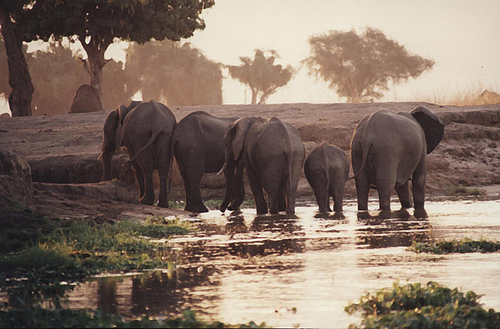

Location: Map
Area: 2,500 sq km
Mana Pools National Park is a nature reserve situated in the
Northern Zimbabwe. Mana Pools National Park protects an area of
2,500 sq km. Mana Pools National Park protect an extensive area in
the lower Zambezi River that floods large expanses of African
savanna. Pools and lakes that are formed here fill up and dry up
during the year. Numerous animals come here in large areas as it is
one of the few large sources of available fresh water. The name of
the "Mana" protected area comes from a local dialect of Shona
language that can be translated as "four" in reference to four large
lakes that are usually remain filled with water through out the
year.
Mana Pools National Park is inhabited by herds of
antelopes, lions, elephants, leopards, spotted hyenas and other
mammals. In addition to land safari tourists can take a canoe safari
over Zambezi River, however it should be taken in consideration that
the waters of rivers, pools and lakes are filled with hippos and
crocodiles.
Best time to visit
Mono Pools National Park
are particularly popular during dry season that includes June
through October. Diminished water sources increases the density of
large game that stay close by water sources. It is also one of the
cooler months of the year. During the night the temperatures might
deep fairly low. So bring warm clothes or blankets at night.
Wet green season in the Mana Pools National Park last between
December and February. Dry savannah changes its appearance and turns
into a blanket of flowers. However flash floods make it difficult
and sometimes dangerous to travel through the rugged terrain.
Human influences
The construction of the Kariba Dam above the
flood plain in the 1950s changed the timing and magnitude of the
flooding. However, the extent to which this has negatively affected
wildlife is not clear. What is undisputed is that the dam holds back
mud that would otherwise be washed into the plain. The associated
lower nutrient input affects the food basis for herbivores. Another
problem is the excessive grazing of the trees by elephants.
In the 1980s, proposals were made to build a dam downstream at the
Mupata Gorge, which threatened to permanently inundate larger areas
of the floodplain. It is claimed that the designation of the
national park was carried out, among other things, to prevent this
project. However, this project is still regularly mentioned in
feasibility studies.
Landscape
The landscape is shaped by
the changing water level of the Zambezi. There are shore landscapes,
islands, sandbanks and pools. Drier areas are overgrown by a forest
of mahogany, ebony, baobab and wild fig. The river and floodplain
are bordered by sheer cliffs.
Wildlife
Since the
permanently water-bearing ponds are the only source of water in the
wide area during the dry season, numerous animals gather here. The
area is therefore popular for observing large animals. These include
lion, African elephant, African buffalo, leopard and cheetah.
Numerous Nile crocodiles and hippos from the Zambezi side arms,
which dry up in summer, retreat to the few remaining bodies of water
(pools).
Some of the 500 black rhinos remaining when the park
was established have fallen victim to poachers, but most have been
relocated to other national parks in Zimbabwe.